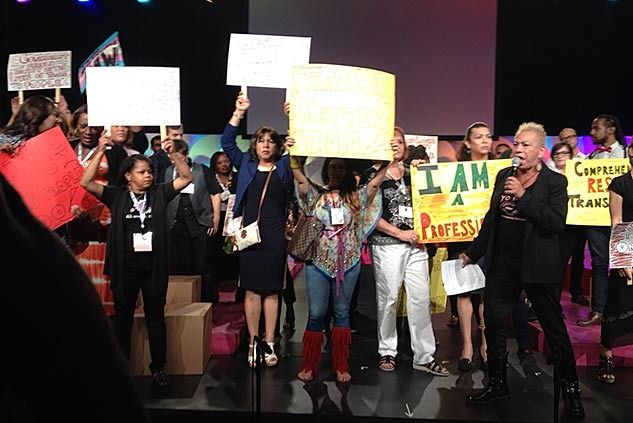
The 2015 US Conference on AIDS was held September 10-13 in Washington, DC. On the opening day dozens of transgender and gender-nonconforming people seized the stage at the lunchtime plenary session to draw attention to HIV+ gender-variant people.
The group was chanting, We are not gay men! to protest the inclusion of trans women in gay male research and statistics.
Spokeswoman Bamby Salcedo, a Latina trans woman, activist, and subject of the documentary TransVisible, wore combat boots and looked ready for battle as she grabbed the microphone during the unexpected protest at the lunch-time plenary.
The activists were applauded by the audience and welcomed by Paul Kawata, the executive director of the National Minority AIDS Council.
In fact, Salcedo was allowed to speak for nearly 20 minutes as she outlined a list of actions the group called for, including a demand that the federal government set aside research money to study trans women and HIV. Despite the fact that trans women represent one of the highest at-risk populations they are rarely included in HIV studies, and when included they are frequently misgendered as men who have sex with men.
We’re a vast community of diverse people who we don’t always understand but love anyway. It’s that courage to stand up to put your ass on line. If you’re not willing to put your ass on the line, this is not the movement for you.
–Kawata
Bamby, watching your anger and your passion nearly brought me to tears.
–Former Director of the Office of National AIDS Policy Jeffrey Crowley
One of the scheduled speakers at the Plenary was Noël Gordon, Foundation Project Manager at the
Human Rights Campaign.
I challenge all of us to do something to help end the epidemic of HIV and the violence affecting the transgender community in this country and around the world.
–Gordon
The current Director of ONAP is Douglas Brooks. He was in the room when the protest took place. It was aimed at ONAP”S recently released new and updated National AIDS Strategy.
In the previous HIV/AIDS strategy, the trans community was mentioned. Things were supposed to be implemented, but that never happened.
–Salcedo
The new plan abandons the trans-specific strategies altogether, essentially erasing the unique experiences of transgender people with HIV, what Salcedo describes as “structural violence.”
The primary demand was thus to collect data specifically about the experience of transgender people with HIV.”We recommended collecting data on transgender people ten years ago,” Salcedo explained, noting that it still hasn’t happened. “We need to have ways of collecting data that are specific to our communities,” which continue to be marginalized. According to the 2011 National Transgender Discrimination Survey, trans people reported HIV infection at four times the national average, with rates even higher for trans people of color.
Unfortunately, we live in a society where we play the numbers game. Trans people and people of color, our community is non-existent [in the data]. There’s no way to prove the needs of people. Numbers should be collected about our existence and our needs.
We have to intentionally invest in the lives of transgender people. If there’s no research, we’re nonexistent.
–Salcedo
Megan McLemore at Human Rights Watch says it is not only trans women who are omitted from the ONAP Strategy.
Sex workers, who world-wide are HIV infected at 12 times the general adult population, are virtually invisible to the new plan.
The revised version uses the term “sex worker” only twice, both times in discussion of stigma that “can” attach to issues such as substance use, mental health, gender identity and “sex work.”
Its omission from the extensive section on violence against women is most puzzling, as the primary factor that increases sex workers’ HIV risk is violence.
–McLemore
With regard to transgender women, the new Strategy does improve on the old in some respects. The document cites the alarmingly high prevalence (nearly 30% in some studies) of HIV among transgender women in the U.S., and urges addressing violence against transgender women “by research and programmatic activities.” But this falls far short of the full-court press that is needed for a community in crisis; facing high rates of poverty, homelessness and every other social determinant associated with HIV risk; and experiencing more homicides through mid-August 2015 than in all of 2014.
The updated Strategy also fails to address the evidence that, although transgender women face discrimination and violence from a variety of sources, the criminal justice system is a primary intersection of violence and HIV. According to the Bureau of Justice Statistics, 34% of transgender adult inmates reported sexual victimization in U.S. prisons and jails between 2007 and 2012.
–McLemore

1 comments
Author
…believe HIV/AIDS has been defeated are going to find much interest in this, but I try.